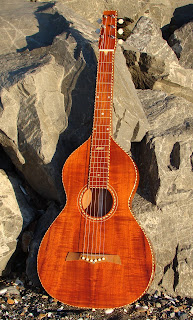Part 4 - Francis / Noe Solid-neck Hawaiian
It is a great privilege and honor to say my collaboration with noted Weissenborn author George T. Noe is now complete.
George (Tom) Noe and Dan Most were the first to talk about Weissenborn instruments in a chronological order, which for me at least, was a reflection of how the design, construction and manufacture of Weissenborn guitars were inextricably linked. For Weissenborn as a maker, that was a relentless pursuit of detail. But for musicians and collectors, we are left with a vast catalog of instruments with different voices.
Since most my my new work is based on the later models, it was a rare opportunity to go back into Weissenborn's early work. And so, this guitar was both one of the most challenging commissions and greatest gifts I have ever been given. Although its construction details are straight ahead, through this guitar I was fortunate enough to study Weissenborn as a violin maker, and how pivotal that was not only in his early work, but how it continued to effect everything he did.
Musically, this guitar bowls over both player and listener alike. For such a small body (both in dimension and just 2.5 inches of depth), it is easily one of the larger sounding instruments I have heard with very strong projection and articulation throughout the range, putting the solid-neck in a class all by its own.
For those who are new to the Solid-neck, you can check out our blog posts on its development, here:
Solid-neck Weissenborns - An Introduction
Solid-neck Weissenborn - Part 2 (The master template)
Solid-neck Weissenborn - Part 3 (Construction)
I would like to extend my greatest thanks to George T. Noe for bringing this project to life. George is one of the kindest and most genuine people one could hope to meet, as well as being the foremost expert on H.Weissenborn. Its been a true honor to work with him on this project and share a magnificent correspondence over the years.
90 years after its was originally designed and constructed, I am happy to say the solid-neck will continue to be available by special order.
















